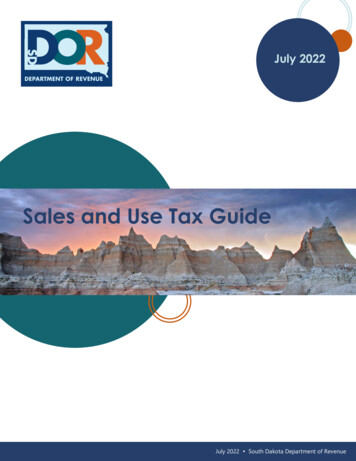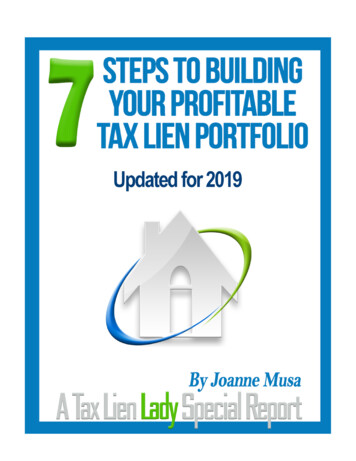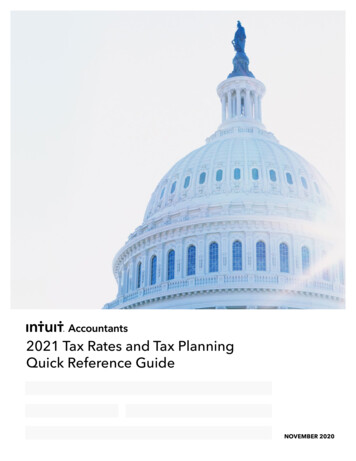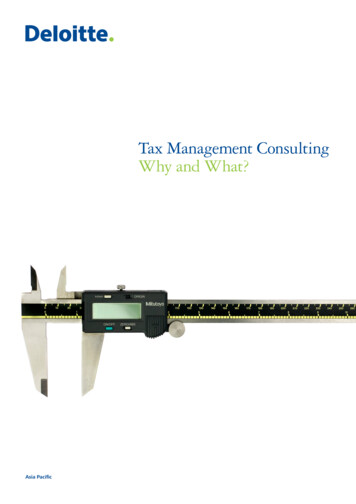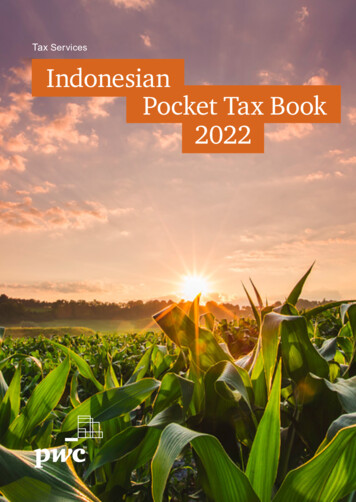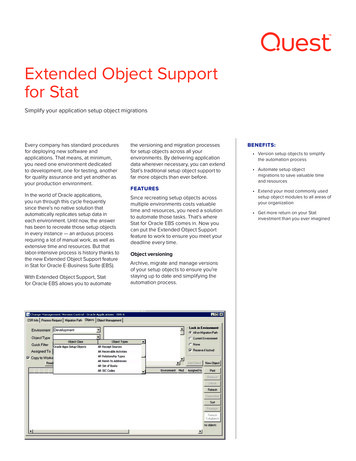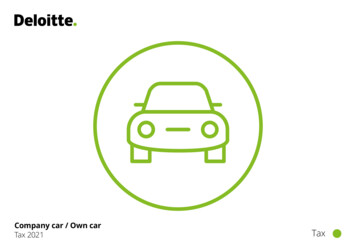
Transcription
Company car / Own carTax 2021Tax
1 Company car / Own carContent1. Company car1.1 Who are comprised1.2 Calculation basis1.3 Taxable value1.4 Availability1.5 Electric cars2. Use of own car for business purposes2.1 Own car2.2 Transportation for business purposes2.3 Tax-free mileage allowance2.4 Set-offs2.5 Documentation and bookkeeping2.6 Reporting3. Leasing3.1 Low-taxed leasing cars3.2 Flex leasing3.3 Split leasing4. Choice of company car scheme4.1 Free app to more platforms
2 Company car / Own carMaking the choice ofoptimum car solutionsis a complicated matter,which requires profoundconsiderations and analyses.The big issue is whether it is an advantage tohave a company car at one’s disposal orwhether it will be better to use one’s own carfor business purposes with the possibility ofmileage allowance. A precise answer requiresconsiderable calculations and dependson thorough knowledge of the rules andpractices of taxation of company car as well asthe conditions for paying out a tax-freemileage allowance when using one’s own carfor business purposes.Deloitte has developed an easily accessiblecalculation model, which on the basis of a fewparameters gives a very precise indication ofwhich choice will be the best in each individualsituation. The model can be downloadedas an app from www.deloitte.dk and is alsodescribed in section 4.This publication contains a brief introduction torules and practices for taxation of freecompany car and payment of tax-free mileageallowance applying as of 1 January 2021.Changes in 2021As part of the political agreement (“greenconversion”) from December 2020 severalchanges have been agreed, which will have animpact on the rules for taxation of freecompany cars.The percentages (25%/20%) for calculating thetaxable value will be changed and thepercentage (150%) for calculation theenvironmental charge will be increased, seesection 1.3. Furthermore, the value of anemployer-paid power charger – installed at theemployee’s residence will be exempt fromtaxation, see section 1.5.The changes will have effect from 1 July 2021for all employees, who are taxed on the value offree company car.1. Company car1.1 Who are comprisedTaxation of company car is triggered when thecar is made available to the employee by anemployer for private purposes. Therefore, therules apply first of all to employees. A cohabitant or spouse’s use of the company car doesnot trigger additional taxation. It is only theemployee who can have a company car at his/her disposal and, consequently, be subject totaxation.The rules also apply to individuals, who aremembers of or assistants for boards,committees, commissions, councils etc. andfor self-employed, who have chosen to applythe rules of the Business Tax Scheme.1.2 Calculation basisCompany car is a taxable benefit and thevalue is calculated as a standard percentageof the car’s calculation basis. It is the mereright of disposal that is taxed. The extent ofprivate use is not important.The calculation basis depends on whetherthe car is more or less than 36 months oldat the time when the employer acquires thecar (conclusion of binding purchase, rentalor leasing agreement).The calculation basis does not change for acompany car (from the set of rules for newcars to the set of rules for used cars) – unlessthe car is actually traded (changes owner) at atime that is more than 36 months after itsfirst registration.Leased company carsThe leasing company must inform the lessee(employer) of the current calculation basisused for the calculating of the taxable value.For the past many years, leasing cars haveoften been registered at very low prices andwith low registration tax – and for companycars, therefore, also with a low tax value.With the amendment of the Registration TaxAct at the end of 2017 (the "Car Package"), aspecial "recalculation" of the registration taxon leasing cars was introduced with acomparison and possible increase after 4months in relation to the market price.As per 1 February 2020 such a recalculationwill also affect the tax calculation basis,however, only with effect for cars madeavailable for the first time (as a free car)from1 February 2020.The leasing company must determine andinform the lessee (employer) of therecalculated value if this leads to a higherbasis of calculation.Purchase of a company car upon the expiry ofthe leasing period is considered change ofownership just like a sale-and-lease-backagreement. If a company car is handed overto an affiliated company, for instance as partof a restructuring, it can be considered anactual change of ownership, whereas sale andrepurchasing of the same car will not beaccepted for tax purposes, unless theagreement can be justified clearly forbusiness purposes.New cars (less than 36 months)The calculation basis for new cars acquiredno more than 36 months after their first
3 Company car / Own carregistration is the original price of the car asnew. This is called a date rule. After the first36 months, the calculation basis is 75% ofthe original price of the car as new. This iscalled the month rule according to which thecalculation basis is reduced on the basis ofthe age of the car by the number of monthsfrom the month of the car's first registration.The original priceThe price of the car as new is the car’s priceincluding the registration tax, VAT, costs ofdelivery and all usual equipment. There is adistinction between usual equipment andextra equipment, pursuant to theRegistration Tax Act.Usual equipment means equipmentsubject to registration tax, including extraequipment in e.g. cars used for campaigns,if the equipment is mounted by themanufacturer or the importer.Pursuant to the Registration Tax Act, extraequipment can be exempted from theregistration tax, if the equipment issupplied and mounted by the dealeraccording to agreement between thedealer and the user, and the equipment isstated separately on the contract as extraequipment.The original price – changed case lawUntil now, it has been an accepted andgeneral interpretation that the “original price”was locked once and for all – by the firstregistration date of the car. Also where thecar was traded within the first 36 monthsthereafter.This interpretation has been changed with a2018 municipal court decision, which wasupheld by the High Court(SKM2019.338.ØLR). In the specific case, acar dealer first registered the car in May 2010as an importer with a value of DKK 467,072.The car was then made available to anemployee of the car dealer, after which thecar was sold to a company in June 2011 forDKK 860,000 for the purpose of being usedas a company car.The High Court upheld the district court'sruling and emphasized that the concept of"original price" in calculating the value of afree car must be understood as the price thatan end user would have to pay at adealership when acquiring the vehicle asnew. After an overall assessment, the originalprice of the car was fixed at DKK 860,000.Therefore, it is always important to considerthe calculation basis soberly when takingover a company car, where an "original price"is stated and be particularly critical of – if thebasis differs from the car's suggested retailprice.Used cars (more than 36 months)The calculation basis for used cars acquiredmore than 36 months after the firstregistration is the employer’s purchase priceincluding any renovation repairs (oppositemaintenance expenses).When it comes to used cars, there is nodistinction between usual equipment andextra equipment. The calculation basis is thetotal purchase price of the car.1.3 Taxable valueThe taxable value of company car isequal to: 25% of the first DKK 300,000 of thecalculation basis. 20% of the amount exceeding DKK300,000. Environmental charge.Irrespective whether the calculation basis isthe price of a new car, 75% of the price of anew car or the purchase price, thecalculation shall always be based on theamount of minimum DKK 160,000.As part of the political agreement fromDecember 2020 (see introduction section) ithas been agreed that the percentage rate of25% will be reduced by 0,5% annually until2025 and the percentage rate of 20% will beincreased by 0,5% annually until 2025 – afterwhich there will be only one rate of 22,5%. Thereduction to 24,5% and the increase to 20,5%will have effect per 1 July 2021.Environmental chargeThe taxable value is increased by anenvironmental charge. The charge is notincluded in the calculation basis, but is added(directly) to the taxable value.The environmental charge, currently 150%,comprises the annual vehicle excise duty(including special charge for diesel carswithout a particle filter, but exclusive ofequalising duty for certain diesel cars andextra charge for private use).As part of the political agreement fromDecember 2020 (see introduction section) ithas been agreed that the environmentalcharge will be increased year by year for allcompany cars until 2025. Per 1 July 2021 theenvironmental charge will be increased to250% and for 2022 to 350%.What is included in the taxable valueOperational costs, when using a companycar, are included in the taxable value, andthe employer can pay these costs withoutthe employee being taxed additionally.These costs are general operational costs,e.g. costs for petrol/diesel, insurances,vehicle excise duty as well as repairs andmaintenance, including drive-on productssuch as oil, wash, windshield fluid etc.
4 Company car / Own carCosts for garage, parking space, parkingcharges, ferry tickets, motorway charges,bridge toll and purchase of roof rack forskies, child seat etc. are not operational costsand, thus, not included in the taxable value. Ifthe employer pays such costs, they will betreated as taxable benefits, which must betaxed separately.Example:The car is registered the first time on 20 October 2017. As from October 2020, the calculation basis isreduced, no matter whether the car is delivered later on, e.g. in November/December -120,000480,000480,000360,00025% of DKK 300,00075,00075,00075,00020% of amounts above36,00036,00012,000DKKPrice of a new car (the original price)Reduction, after 36 monthsCalculation basis Environmental charge(vehicle excise duty DKK 4,500) per yearTaxable value per yearTaxable value per ,8127,812Employee's self-paymentIf, during the income year the employeehas paid the employer – with net pay – forhaving the car at his/her disposal, thetaxable value of the company car will bereduced by an equivalent amount within theyear in question. It is not important whetherthe self-payment is paid by installmentsover the year or as a one-off payment.Payment after 31 December, or to othersthan the employer, who has provided thecompany car, does not reduce the taxablevalue. Costs that the employee payshimself/herself, do, in principle, not reducethe taxable value.However, if the employee pays for generaloperational costs, they can be reimbursedby the employer as an outlay according toreceipts submitted, or they can be set-offagainst the taxable value as a user charge, ifthe employer does not want to reimbursethem, see below.For instance, if the employee pays for petrolabroad – or other general operational costs –they can be considered self-payments and,thus, reduce the taxable value of the companycar. It is, however, a condition that: The employee submits the original receiptsto the employer. The employer books the amount as anoperational cost and at the same timecredits an equivalent amount as income inthe form of self-payment in the companycar accounts.Gross salary reductionIt is insignificant whether a company car isincluded as part of the total remunerationpackage or the employee contributes directlyto the financing by accepting a general andactual salary reduction.A reduction of the gross/cash salary is notconsidered a self-payment for tax purposes,because it is not made with net pay.Consequently, taxation will take placeaccording to the ordinary rules, and a salaryreduction can neither be set-off against norreduce the tax value.1.4 AvailabilityIf the car is only available for private use partof the year, the tax value will be reduced bythe number of months during which the carwas not available to the employee. In thisrespect, one month is a continuous 30 dayperiod and not a calendar month. Forinstance, if the car has been available for
5 Company car / Own carthe period 1 January to 20 June and 10 Augustto 31 December, the employee must be taxedof 11/12 of its annual value, because theperiod with no car available is more than 30days, but less than 60 days.In case of an occasional loan of a companycar, the employee will also be taxed accordingto the ordinary rules. This means that anemployee must be taxed for a whole year,however, a deduction for the number ofwhole months during which the car was notavailable will be granted. This means that aloan/availability period of only a few hoursactually triggers taxation of the value of acompany car for minimum one month (1/12of the annual value).In case of changing cars in the middle of acalendar month, taxation of both cars shouldin principle be triggered in the actual month.However, if both cars have not been availableat the same time, it will be accepted that onlythe most expensive of the cars is taxedduring the actual month.The same applies, if an employee changesjob in the middle of a month and has acompany car available from bothworkplaces. In this case, the first employermust calculate and tax the value of thecompany car for the whole month accordingto general terms and conditions.The new employer must also calculate thevalue of company car for the whole monthduring which the employee startsemployment, but can against docu-mentationset-off the value of the company car that hasbeen reported by the previous employer.In the opinion of the Danish Tax Agency thecase law for majority shareholders haschanged on the basis of SKM2019.337.BR,however, under special conditions asindicated in the control signal,SKM2020.44.SKTST.Storage/downtime insuranceA frequently asked question is whether it ispossible to avoid taxation of cars, which areeither put away for storage or which arecovered by a downtime insurance forinstance. However, neither downtimeinsurance nor dismounting and deposit ofregistration plates with e.g. an insurancecompany are sufficient to avoid taxation of acompany car.According to new case law, it is possible tocut off the availability of a car even if thelicense plates are not handed over to theMotor Vehicle Agency but simply depositedwith an insurance company or insurancebroker in connection with a downtimeinsurance. However, this must be anindependent third party who has anindependent interest in relation to theinsurance relationship, and this is not thecase when depositing with for example alawyer or an accountant.To avoid taxation of a company car, it isdecisive that an effective “deprivation oftheavailability” has taken place, and thisrequires, in principle, that the car is deregistered in CRM and the registration platesare handed over to the Danish Tax Agency.Majority shareholder – new case lawUntil now, the case law has been that amajority shareholder has not been able todeprive him/herself of the availability of acompany car during a period of downtimeinsurance, unless the car was de-registeredfor whole months and the license plates arehanded over to the Motor Vehicle Agency.1.5 Electric carsAn electric car is, in principle, comprised bythe general rules on taxation of company car,if the car is made available for private use. Thecosts for electricity for recharging the car areincluded and treated in the usual way as costsfor petrol/diesel etc.If the employer pays costs related to theinstallation of a power charger at theemployee’s residence, the amount should beadded to the “calculation basis”.For the period 1 April – 31 December 2020 (9months), a special reduction of DKK 40,000 inthe annual taxable value for all electric, plug-inhybrid and fuel cell cars has been introduced(DKK 3,333 per month).As part of the political agreement fromDecember 2020 (see under introductionsection) it has been agreed that the value of anemployer-paid power charger – installed at theemployee’s residence will be exempt fromtaxation. The change will have effect from 1 July2021.2. Use of own car for business purposesIf the employee uses his/her own car forbusiness purposes, the employer can reimburse operating costs by paying out a tax-freemileage allowance.On the contrary, the employer cannot pay orreimburse actual operating costs concerningthe employee’s private car without taxconsequences.If the employee has other expenses for e.g.bridge tolls, ferry tickets etc. in connection withtransportation for business purposes, thecosts can, however, be covered by theemployer as outlays according to receiptssubmitted. In order to have the expensescovered, it is a condition that the employeecan show original receipts.
6 Company car / Own car2.1 Own carIn order to obtain tax-free mileage allowance,it is a condition that the employee drives inhis/her own car.“Own car” is a car that is registered in theemployee’s own name. A car that is leased inone’s own name (private leasing) is alsoconsidered one’s own car. A car that isregistered in the spouse’s or the cohabitant’sname is considered one’s own car as long asthe parties have joint finances. A car that isregistered in one of the parents’ name is alsoconsidered the son or daughter’s own car,when it can be documented that the son ordaughter is the actual owner of the car, hasfinanced the purchase and pays theoperating costs.2.2 Transportation for business purposesLegislation stipulates the following objectivecriteria for which kind of transportation isconsidered transportation for businesspurposes: Transportation between usual residenceand a workplace for up to 60 working dayswithin the preceeding 12 months. Transportation between workplaces. Transportation within the same workplace.This 60-day rule means that transportation willno longer be considered business-relatedwhen an employee has driven from his/herresidence to a workplace for more than 60working days within a period of 12 months.Therefore, the employee is no longer entitledto a tax-free mileage allowance.When counting the 60 days, it is not importantwhether the transportation has taken place byone’s own car, another person’s car or bypublic transport. The decisive factor is whetherthe employee has transported himself/herselfbetween his/her residence and the specificworkplace for more than 60 working dayswithin a preceding 12 month period.If the employee has a transport patternthat implies transportation to so many differentworkplaces that it is not likely that transportation between usual residence and the workplace will occur for more than 60 working dayswithin a 12 month period, the transportationcan be considered made for businesspurposes. There is no direct requirement tocontrol that the rule has been complied with.The Danish Tax Agency can, however, withfuture effect for up to 12 months, imposewritten orders that it should be documentedthat the transportation is actually businessrelated (e.g. by making mileage accounts).2.3 Tax-free mileage allowanceBoth Danish and foreign employers andassignors can pay out tax-free mileageallowance to the employee fortransportation in his/her own car forbusiness purposes.For 2021 the National Assessment Councilhas determined these rates: DKK 3.44 per kilometre for the first 20,000kilometresmust be calculated on the basis of therates that applied on the date of thetransportation – even though the actualpayout will be made in the subsequentincome year/calendar year.If the employer pays out a tax-free mileageallowance by rates that are lower than therates stipulated by the NationalAssessment Council, the employee cannotdeduct the differential amount betweenthe allowance and rates. DKK 1.90 per kilometre beyond this limitThe total annual number of kilometres drivenin the income year referred to is decisive forwhether the kilometres driven justify the highor the low rate.When the limit of 20,000 kilometres forbusiness purposes in the individual calendaryear is exceeded, the rate will be reduced. Ifan employee has several employers at thesame time or during the year, the 20,000kilometre limit will apply to each employer.It is the actual number of kilometres drivenduring the calendar year, which decideswhich rate to be used. Thus the mileageallowanceIf no allowance for transportation by one’sown car for business purposes is paid out,the employee will instead be entitled to atax deduction (according to the rules andby the rates for transportation betweenhome and work).If an allowance is paid out by rates thatare higher than the National AssessmentCouncil rates, the entire amount will betaxable as personal income, unless theamount is divided at the time of payoutand the part of the amount that exceedsthe rates is treated as salary. In this case,taxes should be withheld in connectionwith the payout.
7 Company car / Own car2.4 Set-offsFixed monthly or annual payouts of mileageallowance are taxable and considered salary.Mileage allowance is also taxable, if it is set-offfully or partly against cash salary alreadyagreed upon.The tax exemption is conditioned by theemployee not having compensated his/heremployer in connection with payout of tax-freeallowance. If concurrently with payout ofallowance, the employer has agreed with theemployee to reduce his/her gross salary, showsalary restraint or receive a lower salary at his/her employment, the allowance paid out willbe taxable.2.5 Documentation and bookkeepingIn order for the employee to receive a tax-freemileage allowance, the employer must checkthe number of kilometres driven.The allowance must be settled by submitting adocument containing information about:: The recipient’s name, address and civilregistration no. (CPR-number). The business purpose of the transportation. Date of the transportation. The objective of the transportation. Number of kilometres driven. Rates applied. Calculation of the mileage allowance.The demand on employer control proceduresmeans that the documentation must becompleted carefully and that it must containall necessary information.In our opinion, the conditions must beconsidered fulfilled, if the above items can beidentified through a salary/employee no. Thismeans that, if the name, civil registrationnumber, rates and calculation are stated onthe payslip, and the information about date,purpose and address etc. is registered in an ITsystem, the documentation requirements areconsidered fulfilled.The employer must check the number ofkilometres driven effectively, and, therefore,the person approving the payout must be ableto identify the destination stated. Stating acompany name or an in-house term is inprincipal not enough. The exact address mustbe stated. The voucher should be signed bythe person checking them.2.6 ReportingPayout of tax-free mileage allowance must bereported, and the employer is liable to reportthe amounts paid out on a month-by-monthbasis to eIncome in box 48 with seperatelyincome type, code 0109.3. LeasingIf the employer leases a car and makes itavailable to the employee as a company car,the employee will be tax liable according to thesame rules applying for cars owned by thecompany. The calculation basis is determinedas if the car was purchased by the employer atthe time of leasing the car.If the car is leased no more than 36 monthsafter the car’s first registration, the car will bevalued on the basis of the price of a new car. Ifthe leasing agreement has been concludedmore than 36 months after the car’s firstregistration, an estimated market value of thecar at the time of concluding the agreementwill be used as basis for the calculation.3.1 Low-taxed leasing carsEven though the rules of taxation of companycars are identical – irrespective whetherthe employer purchases or leases the car, it is,however, a fact that a car model with thesame equipment is often taxed lower, if it isleased compared to a purchased car. This issolely due to the fact that the leasing companies (who own the car) can purchase the carat a lower price than the price at which anemployer can purchase it.However, as per 1 February 2020 a tighteninghas been introduced so that "recalculation" ofthe registration tax also affects the tax calculation basis. For more, see under “Leasingcompany cars” in chapter 1.2.In addition, the leasing companies have thepossibility of only settling a proportional partof the registration duty for the period that theleasing agreement covers. This does, however,not affect the taxation basis. Proportionalcalculation and settlement of the registrationduty are often referred to as flex leasing,described in section 3.2 below.3.2 Flex leasingIn everyday speech, flex leasing is the situationwhere the leasing company has the possibilityof settling a proportional registration duty.Very often, the model is described ascontinuous settlement of the duty, however,this is not correct.
8 Company car / Own carA very special rule makes it possible forthe leasing companies only to settle aproportional part of the total registration duty.This is an exception from the ordinary rulesregarding payment of full registration duty, whenthe car is registered in Denmark for the first time.The registration duty is calculated in the usualway, and, subsequently, the leasing company ischarged with a proportional part – equivalent tothe leasing period. The proportional duty is,however, paid upfront, and, therefore, thepayment is not continuous.Only leasing companies that lease out carscommercially can apply the rule. Individualscannot use the rules.3.3 Split leasingThe model consists of two independentleasing agreements: One agreement between the leasingcompany and the employer, which coversworking hours and transportation forbusiness purposes. One agreement between the leasingcompany and the employee, which coversspare time and transportation for privatepurposes.The model is to ensure that the employer aswell as the employee pays exactly each theirpart of the total costs on the basis of a detailedmileage log.As the employee pays all costs and bears thefinancial risk regarding all privatetransportation, the employer has not madethe company car available to the employee forprivate purposes. Therefore, no taxation willoccur according to the general rules oftaxation of company car.The Danish Tax Agency has approved thescheme provided that the followingrequirements of the wording of leasingagreements and mileage logs are fulfilled:Split leasing arrangements Separate, written leasing agreementsbetween the leasing company/employer andthe leasing company/employee must beconcluded. The leasing agreements must beindependent, and the parties must solely beliable for their own obligations in relation tothe leasing company. The employer has the preferential right touse the car during working hours, and theemployee has preferential right to use thecar at other times (spare time). The lease payment and all operational costsare for each of the parties settled directly withthe leasing company. The lease payment that covers the totaloperational costs, depreciation and interestpayment is split proportionally between theparties on the basis of the actual kilometresdriven. The leasing agreements are required to beidentical, so that each party pays exactly thesame amount per kilometre driven. An ongoing settlement and adjustment ofthe distribution of lease payments must bemade, including both the extraordinary firsttime payment, ordinary lease payments andoperating expenses etc. The current payment must be made in sucha way that the payments at all times reflectthe distribution between the actual numberof kilometres traveled for business andprivate driving, i.e. based on the accumulatedmileage and the accumulated paymentsmade over the entire lease period.Mileage log – split leasingIn order to ensure that the employer onlypays the costs related to business driving, adetailed and complete mileage log must bemade continuously, and it must cover theactual kilometres driven split betweenbusiness and private purposes, respectively.Split leasing in practiceThe employer must in no way finance, beliable for or guarantee the employee’sobligations vis-à-vis the leasing company.In order for the scheme to be practicable andat the same time comply with The Danish TaxAgency's terms and conditions, it is requiredthat each party settles all operational costs(including costs for petrol) proportionally anddirectly with the leasing company. In this way,it is ensured that each individual scheme isdivided effectively between the parties.Split leasing cannot be used for self-employedbusinessmen, even though the Business TaxScheme is applied, since the self-employedbusinessman is one and the same legalperson. If a leased car that is used for mixedpurposes is kept out of the Business TaxScheme, the actual costs for using the car forbusiness purposes can be refunded, and,consequently, the model will in practice havethe same effect as split leasing.
9 Company car / Own car4. Choice of company car schemeThe choice between own car or company carusually attracts great attention. The basis forchoosing company car or own car is primarilythe financial consequences for both theemployer and the employee.It is difficult to give a precise answer as to whenit is most financially advantageous for theparties to prefer the one model to the other, asit depends on each individual situation.For the employer, it is most often a decisivefactor whether the costs are unchanged,irrespective whether a company car is madeavailable to the employee, or the employeereceives a higher salary combined with tax-freemileage allowance when using his/her own carf
1 Company car / Own car 1.Company car 1.1 Who are comprised 1.2 Calculation basis 1.3 Taxable value 1.4 Availability 1.5 Electric cars 2.Use of own car for business purposes 2.1 Own car 2.2 Transportation for business purposes 2.3 Tax-free mileage allowance 2.4 Set-offs 2.5 Documentation and bookkeeping 2.6 Reporting 3.Leasing 3.1 Low-taxed .



